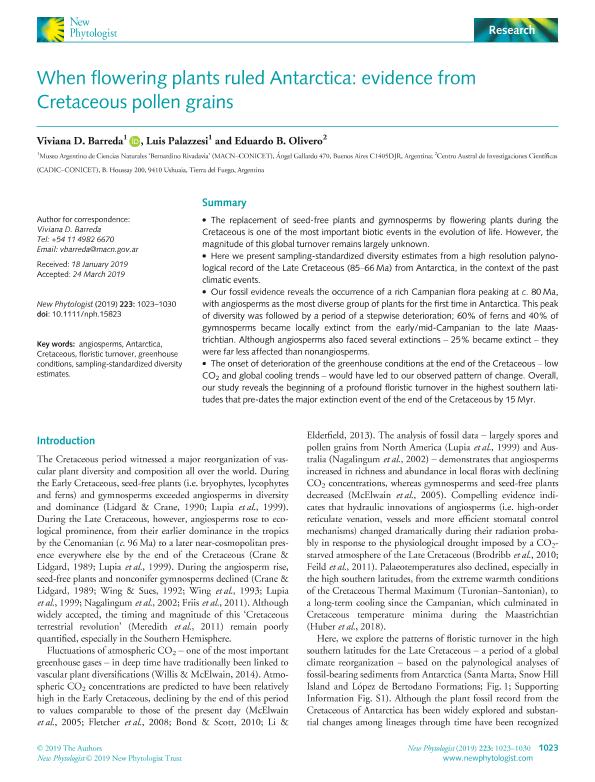Artículo
When flowering plants ruled Antarctica: evidence from Cretaceous pollen grains
Fecha de publicación:
07/2019
Editorial:
Wiley Blackwell Publishing, Inc
Revista:
New Phytologist
ISSN:
0028-646X
Idioma:
Inglés
Tipo de recurso:
Artículo publicado
Clasificación temática:
Resumen
The replacement of seed-free plants and gymnosperms by flowering plants during the Cretaceous is one of the most important biotic events in the evolution of life. However, the magnitude of this global turnover remains largely unknown. Here we present sampling-standardized diversity estimates from a high resolution palynological record of the Late Cretaceous (85–66 Ma) from Antarctica, in the context of the past climatic events. Our fossil evidence reveals the occurrence of a rich Campanian flora peaking at c. 80 Ma, with angiosperms as the most diverse group of plants for the first time in Antarctica. This peak of diversity was followed by a period of a stepwise deterioration; 60% of ferns and 40% of gymnosperms became locally extinct from the early/mid-Campanian to the late Maastrichtian. Although angiosperms also faced several extinctions – 25% became extinct – they were far less affected than nonangiosperms. The onset of deterioration of the greenhouse conditions at the end of the Cretaceous – low CO2 and global cooling trends – would have led to our observed pattern of change. Overall, our study reveals the beginning of a profound floristic turnover in the highest southern latitudes that pre-dates the major extinction event of the end of the Cretaceous by 15 Myr.
Archivos asociados
Licencia
Identificadores
Colecciones
Articulos(CADIC)
Articulos de CENTRO AUSTRAL DE INVESTIGACIONES CIENTIFICAS
Articulos de CENTRO AUSTRAL DE INVESTIGACIONES CIENTIFICAS
Articulos(MACNBR)
Articulos de MUSEO ARG.DE CS.NAT "BERNARDINO RIVADAVIA"
Articulos de MUSEO ARG.DE CS.NAT "BERNARDINO RIVADAVIA"
Citación
Barreda, Viviana Dora; Palazzesi, Luis; Olivero, Eduardo Bernardo; When flowering plants ruled Antarctica: evidence from Cretaceous pollen grains; Wiley Blackwell Publishing, Inc; New Phytologist; 223; 2; 7-2019; 1023-1030
Compartir
Altmétricas




